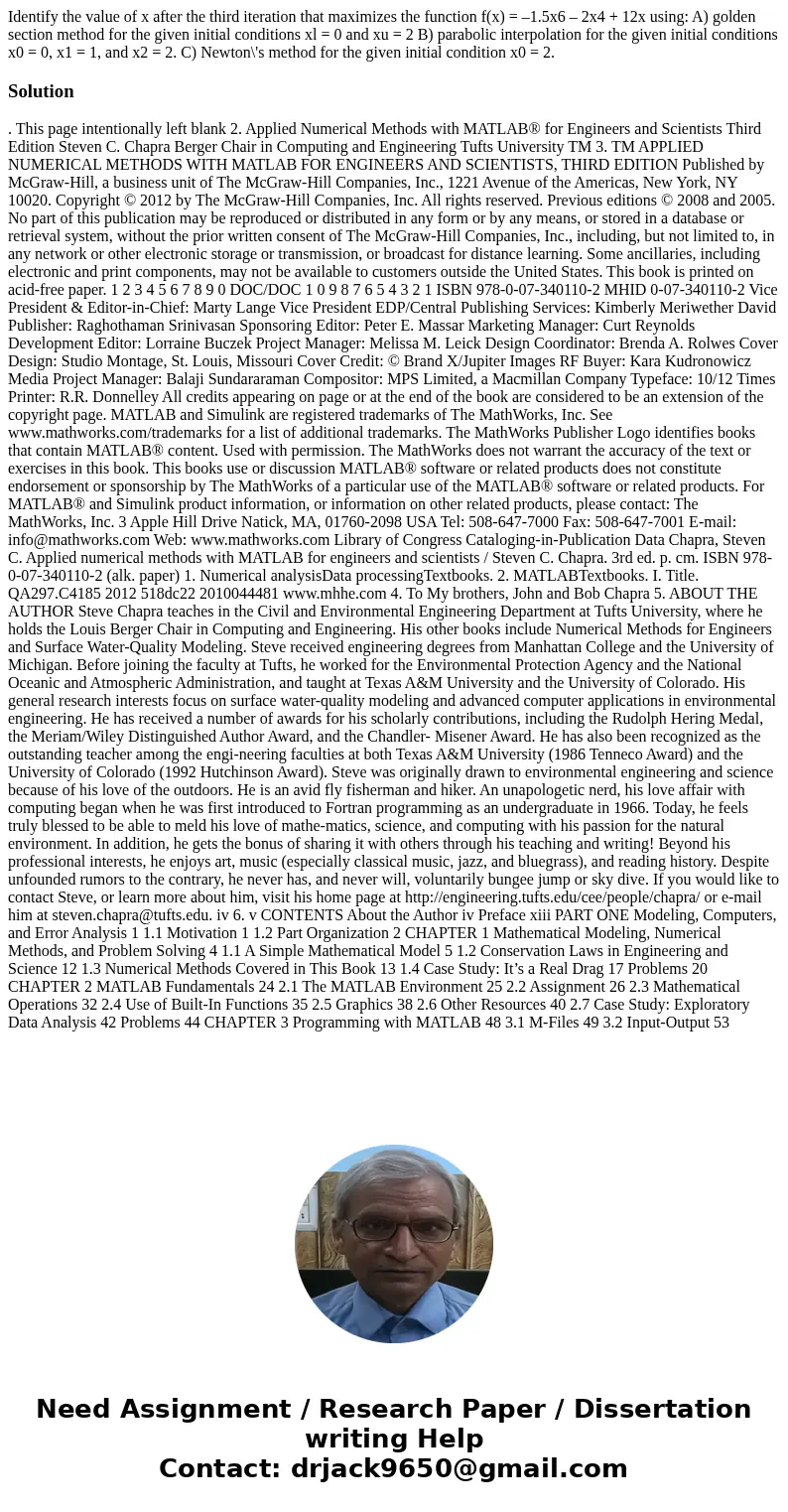Identify the value of x after the third iteration that maxim
Identify the value of x after the third iteration that maximizes the function f(x) = –1.5x6 – 2x4 + 12x using: A) golden section method for the given initial conditions xl = 0 and xu = 2 B) parabolic interpolation for the given initial conditions x0 = 0, x1 = 1, and x2 = 2. C) Newton\'s method for the given initial condition x0 = 2.
Solution
. This page intentionally left blank 2. Applied Numerical Methods with MATLAB® for Engineers and Scientists Third Edition Steven C. Chapra Berger Chair in Computing and Engineering Tufts University TM 3. TM APPLIED NUMERICAL METHODS WITH MATLAB FOR ENGINEERS AND SCIENTISTS, THIRD EDITION Published by McGraw-Hill, a business unit of The McGraw-Hill Companies, Inc., 1221 Avenue of the Americas, New York, NY 10020. Copyright © 2012 by The McGraw-Hill Companies, Inc. All rights reserved. Previous editions © 2008 and 2005. No part of this publication may be reproduced or distributed in any form or by any means, or stored in a database or retrieval system, without the prior written consent of The McGraw-Hill Companies, Inc., including, but not limited to, in any network or other electronic storage or transmission, or broadcast for distance learning. Some ancillaries, including electronic and print components, may not be available to customers outside the United States. This book is printed on acid-free paper. 1 2 3 4 5 6 7 8 9 0 DOC/DOC 1 0 9 8 7 6 5 4 3 2 1 ISBN 978-0-07-340110-2 MHID 0-07-340110-2 Vice President & Editor-in-Chief: Marty Lange Vice President EDP/Central Publishing Services: Kimberly Meriwether David Publisher: Raghothaman Srinivasan Sponsoring Editor: Peter E. Massar Marketing Manager: Curt Reynolds Development Editor: Lorraine Buczek Project Manager: Melissa M. Leick Design Coordinator: Brenda A. Rolwes Cover Design: Studio Montage, St. Louis, Missouri Cover Credit: © Brand X/Jupiter Images RF Buyer: Kara Kudronowicz Media Project Manager: Balaji Sundararaman Compositor: MPS Limited, a Macmillan Company Typeface: 10/12 Times Printer: R.R. Donnelley All credits appearing on page or at the end of the book are considered to be an extension of the copyright page. MATLAB and Simulink are registered trademarks of The MathWorks, Inc. See www.mathworks.com/trademarks for a list of additional trademarks. The MathWorks Publisher Logo identifies books that contain MATLAB® content. Used with permission. The MathWorks does not warrant the accuracy of the text or exercises in this book. This books use or discussion MATLAB® software or related products does not constitute endorsement or sponsorship by The MathWorks of a particular use of the MATLAB® software or related products. For MATLAB® and Simulink product information, or information on other related products, please contact: The MathWorks, Inc. 3 Apple Hill Drive Natick, MA, 01760-2098 USA Tel: 508-647-7000 Fax: 508-647-7001 E-mail: info@mathworks.com Web: www.mathworks.com Library of Congress Cataloging-in-Publication Data Chapra, Steven C. Applied numerical methods with MATLAB for engineers and scientists / Steven C. Chapra. 3rd ed. p. cm. ISBN 978-0-07-340110-2 (alk. paper) 1. Numerical analysisData processingTextbooks. 2. MATLABTextbooks. I. Title. QA297.C4185 2012 518dc22 2010044481 www.mhhe.com 4. To My brothers, John and Bob Chapra 5. ABOUT THE AUTHOR Steve Chapra teaches in the Civil and Environmental Engineering Department at Tufts University, where he holds the Louis Berger Chair in Computing and Engineering. His other books include Numerical Methods for Engineers and Surface Water-Quality Modeling. Steve received engineering degrees from Manhattan College and the University of Michigan. Before joining the faculty at Tufts, he worked for the Environmental Protection Agency and the National Oceanic and Atmospheric Administration, and taught at Texas A&M University and the University of Colorado. His general research interests focus on surface water-quality modeling and advanced computer applications in environmental engineering. He has received a number of awards for his scholarly contributions, including the Rudolph Hering Medal, the Meriam/Wiley Distinguished Author Award, and the Chandler- Misener Award. He has also been recognized as the outstanding teacher among the engi-neering faculties at both Texas A&M University (1986 Tenneco Award) and the University of Colorado (1992 Hutchinson Award). Steve was originally drawn to environmental engineering and science because of his love of the outdoors. He is an avid fly fisherman and hiker. An unapologetic nerd, his love affair with computing began when he was first introduced to Fortran programming as an undergraduate in 1966. Today, he feels truly blessed to be able to meld his love of mathe-matics, science, and computing with his passion for the natural environment. In addition, he gets the bonus of sharing it with others through his teaching and writing! Beyond his professional interests, he enjoys art, music (especially classical music, jazz, and bluegrass), and reading history. Despite unfounded rumors to the contrary, he never has, and never will, voluntarily bungee jump or sky dive. If you would like to contact Steve, or learn more about him, visit his home page at http://engineering.tufts.edu/cee/people/chapra/ or e-mail him at steven.chapra@tufts.edu. iv 6. v CONTENTS About the Author iv Preface xiii PART ONE Modeling, Computers, and Error Analysis 1 1.1 Motivation 1 1.2 Part Organization 2 CHAPTER 1 Mathematical Modeling, Numerical Methods, and Problem Solving 4 1.1 A Simple Mathematical Model 5 1.2 Conservation Laws in Engineering and Science 12 1.3 Numerical Methods Covered in This Book 13 1.4 Case Study: It’s a Real Drag 17 Problems 20 CHAPTER 2 MATLAB Fundamentals 24 2.1 The MATLAB Environment 25 2.2 Assignment 26 2.3 Mathematical Operations 32 2.4 Use of Built-In Functions 35 2.5 Graphics 38 2.6 Other Resources 40 2.7 Case Study: Exploratory Data Analysis 42 Problems 44 CHAPTER 3 Programming with MATLAB 48 3.1 M-Files 49 3.2 Input-Output 53
 Homework Sourse
Homework Sourse